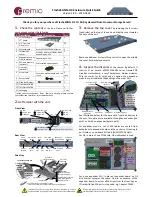
Travelstar 5K160 (SATA) Hard Disk Drive Specification
50/167
12.3.2
Emergency unload
When HDD power is interrupted while the heads are still loaded, the microcode cannot operate and
the normal 5V power is unavailable to unload the heads. In this case, normal unload is not possible,
so the heads are unloaded by routing the back-EMF of the spinning motor to the voice coil. The
actuator velocity is greater than the normal case, and the unload process is inherently less
controllable without a normal seek current profile.
Emergency unload is intended to be invoked in rare situations. Because this operation is inherently
uncontrolled, it is more mechanically stressful than a normal unload.
A single emergency unload operation is more stressful than 100 normal unloads. Use of emergency
unload reduces the start/stop life of the HDD at a rate at least 100X faster than that of normal
unload, and may damage the HDD.
12.3.3
Required power-off sequence
Problems can occur on most HDDs when power is removed at an arbitrary time. Examples:
Data loss from the write buffer.
If the drive is writing a sector, a partially-written sector with an incorrect ECC block results. The sector
contents are destroyed and reading that sector results in a hard error.
Heads possibly land in the data zone instead of landing zone, depending on the design of the HDD.
You may then turn off the HDD in the following order:
1.
Issue Standby Immediate or sleep command.
2.
Wait until COMMAND COMPLETE STATUS is returned. (It may take up to 350 ms in typical case)
3.
Terminate power to HDD.
This power-down sequence should be followed for entry into any system power-down state, or system
suspend state, or system hibernation state. In a robustly designed system, emergency unload is
limited to rare scenarios such as battery removal during operation.
12.4
Sector Addressing Mode
All addressing of data sectors recorded on the device’s media is by a logical sector address. The
logical CHS address for HTS5416XXJ9SA00 is different from the actual physical CHS location of the
data sector on the disk media.
HTS5416XXJ9SA00 support both Logical CHS Addressing Mode and LBA Addressing Mode as the
sector addressing mode.
The host system may select either the currently selected CHS translation addressing or LBA
addressing on a command-by-command basis by using the L bit in the DEVICE register. So a host
system must set the L bit to 1 if the host uses LBA Addressing mode.
12.4.1
Logical CHS Addressing Mode
The logical CHS addressing is made up of three fields: the cylinder number, the head number and
the sector number. Sectors are numbered from 1 to the maximum value allowed by the current CHS
translation mode but can not exceed 255(0FFh). Heads are numbered from 0 to the maximum value
allowed by the current CHS translation mode but can not exceed 15(0Fh). Cylinders are numbered
from 0 to the maximum value allowed by the current CHS translation mode but cannot exceed
65535(0FFFFh).
When the host selects a CHS translation mode using the INITIALIZE DEVICE PARAMETERS
command, the host requests the number of sectors per logical track and the number of heads per
logical cylinder. The device then computes the number of logical cylinders available in requested
mode.
















































